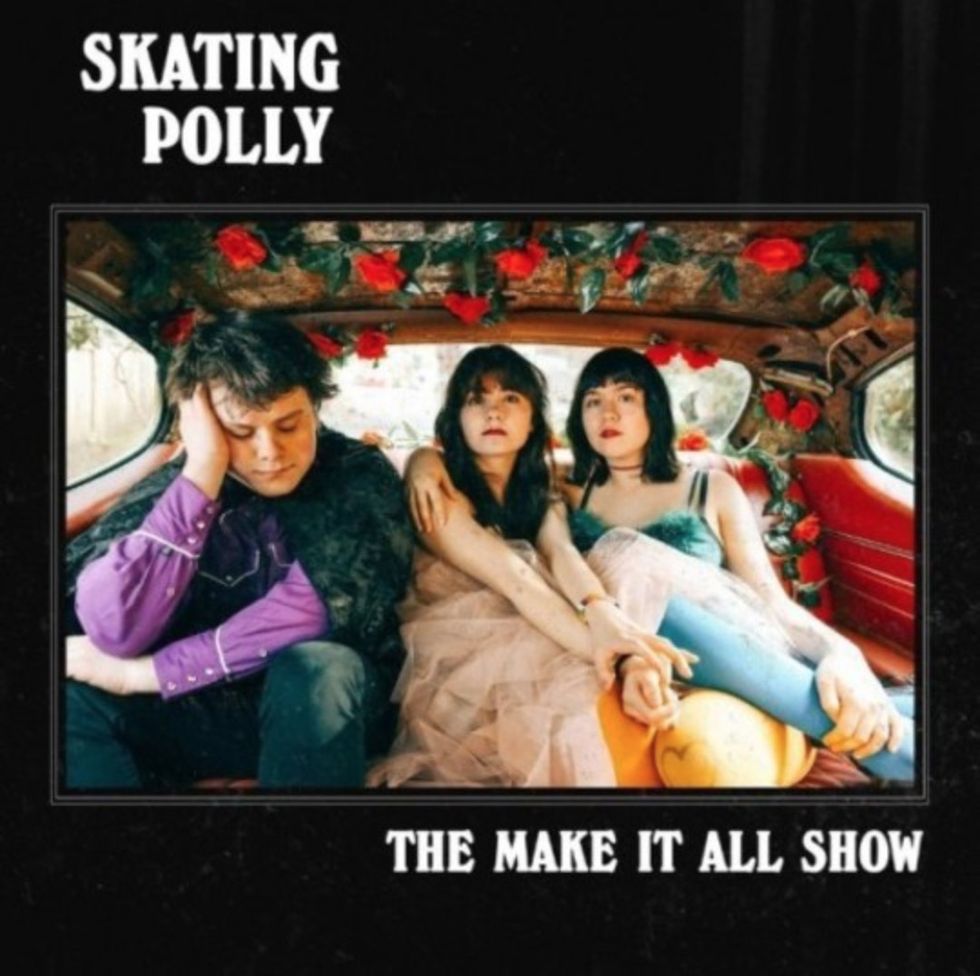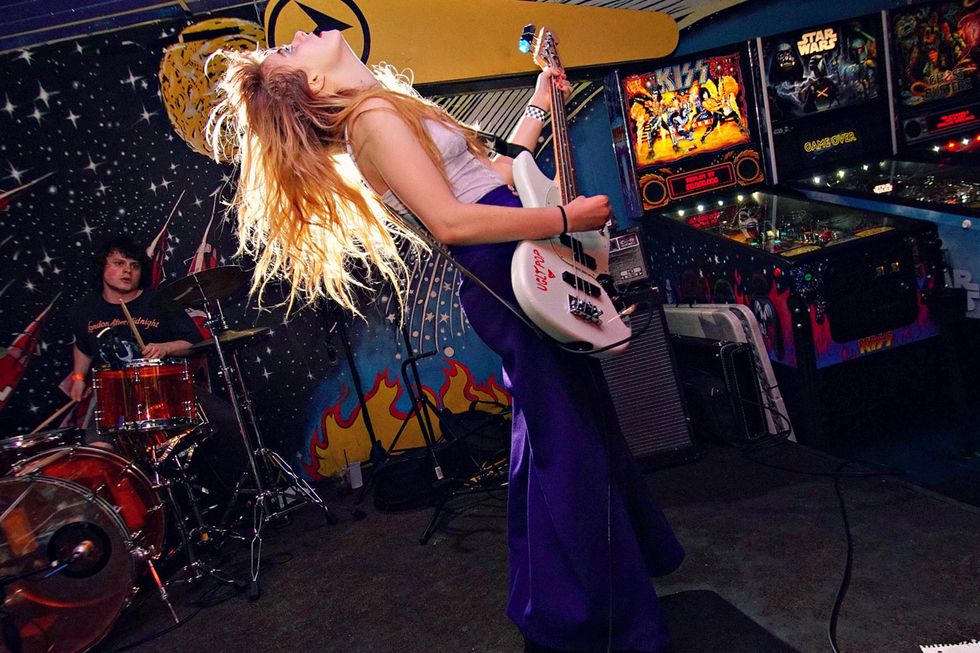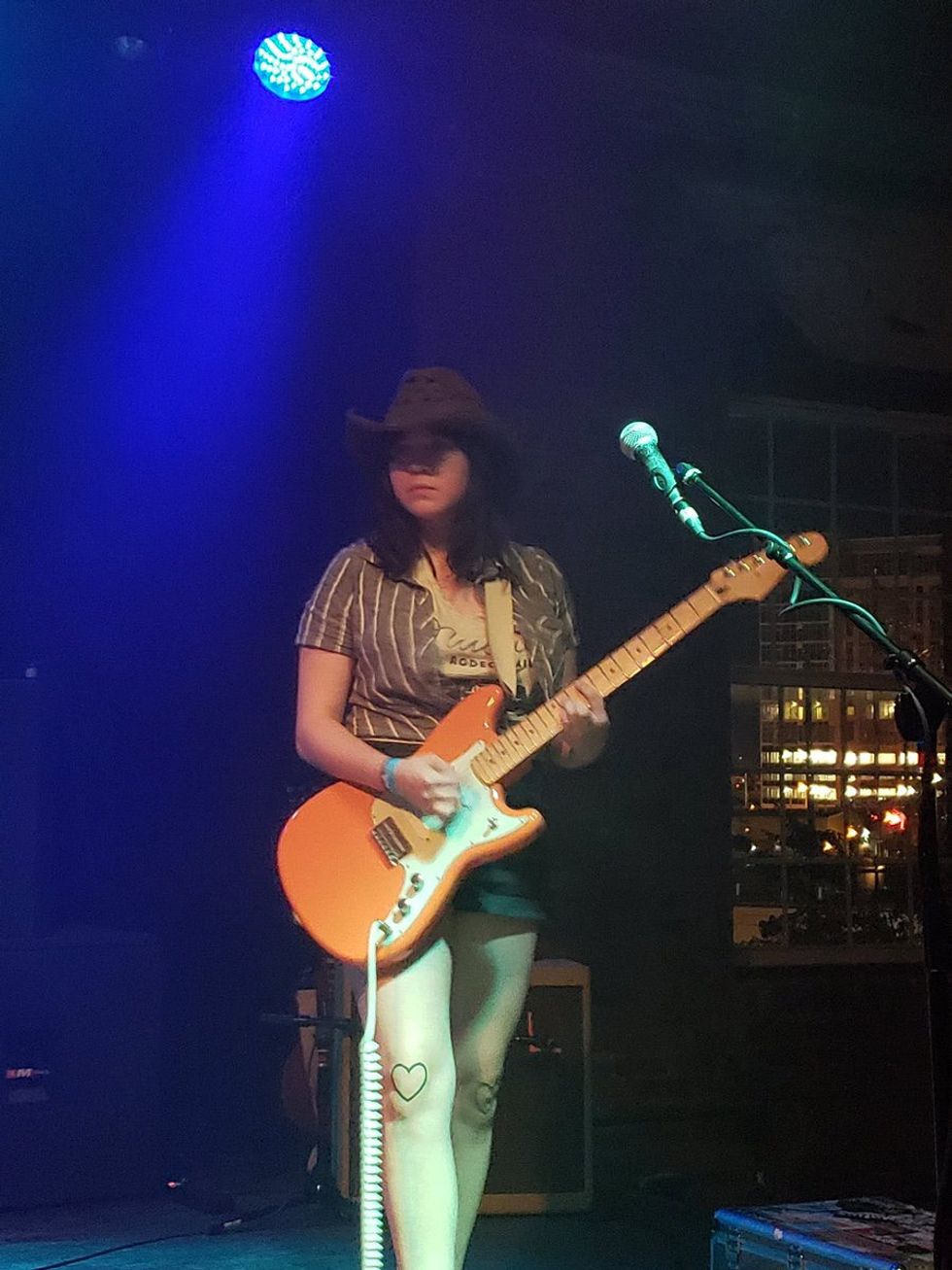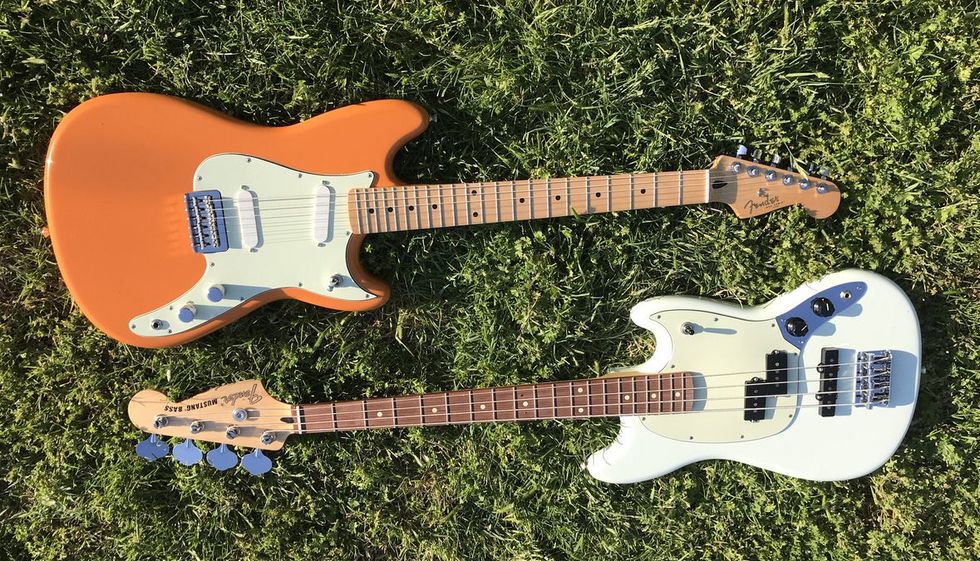You won’t find many artists whose entire musical history is posted online. But Skating Polly, an edgy, DIY, punk-ish outfit from Oklahoma City—although now based in Tacoma, Washington—is one of them. Their first gigs, early experiences with instruments, early promos, and even their first airplay on local radio is up on YouTube alongside their current releases, polished videos, and mature output.
Skating Polly started in 2009, when stepsisters Kelli Mayo and Peyton Bighorse were just 9 and 14 years old. “I am the little sister of the group,” Mayo says. “When Peyton was 14, she said, ‘I am going to start a band,’ and I said, ‘I am going to be in your band. Can I be in your band?’ But she said, ‘I don’t know. I think I’m going to start a band with people in high school.’” But Mayo—undeterred and persistent—wrote a few songs and convinced Bighorse to perform with her at a Halloween party (remember, she was just 9 years old). The next year they were playing local clubs (you can watch their first club gig here).
“When we were younger, Kelli’s dad would go on tour with us and take us to shows,” Bighorse says about their early years. “Our parents have always been really supportive. They would let us miss a lot of school to do shows and they would miss work to come to gigs. Now we tour by ourselves and they are still really supportive, but they don’t have to sacrifice as much.”
The sisters were cute—and, over the years of videos and photos, you can see them grow up, get taller, wear braces, master their instruments, and grow into their voices—but Skating Polly was never a novelty act. Many of those early videos are from tours or appearances at major festivals like South by Southwest. They released their first album, Taking Over the World, in 2011, and have released an album nearly every year ever since. They also caught the attention of Exene Cervenka, from the iconic ’70s/’80s punk band X, who produced their second album, Lost Wonderfuls, and co-wrote and appears on “Queen for a Day” from their current release, The Make It All Show.
For most of their history, Skating Polly was an instrument-swapping duo. Mayo plays a mutant 3-string bass/bassitar hybrid and Bighorse plays guitar. They both play drums and take turns on lead vocals. However, last year, following the release of their EP, New Trick—a three-song collaboration with Louise Post and Nina Gordon of Veruca Salt—they recruited their brother, Kurtis Mayo, to join the band as drummer and sometime guitarist.
And with that, Skating Polly is ready to conquer the world. Check out YouTube to chart their progress. They’re mature and confident songwriters. Their live show kicks ass. Their videos rule. And their dynamic, punk-influenced, pop-informed aesthetic continues to evolve.
We spoke with Mayo and Bighorse to discuss their studio experiences and rules-centric approach to songwriting, Mayo’s unusual bass tuning, Bighorse’s new Fender Duo-Sonic, and how their band has changed since becoming a trio.
In your videos, it looks like you’re always switching instruments. Who plays what?
Peyton Bighorse: For the most part, I play guitar, though for a few songs I’ll play either bass or drums. Kelli plays a little guitar, but mostly bass, and Kurt plays some guitar but mostly drums.
Kelli Mayo: It depends on the song. Before Kurt was in the band, I was either playing keyboard, my weird 3-string bass, or drums. But now, with Kurtis in the band, I’ve been mostly sticking to my 3-string bass.
That’s a 3-string bass and not a 2-string bassitar?
Mayo: It’s three. It started out with two, like the bands Morphine and the Presidents of United States of America—the C#, G# tuning—but after the first few months I broke it. While it was broken, I wrote songs on a normal bass, but I only wrote songs on the E string. When we decided to get another one, I got a bass body and decided I wanted to add an E string so I could play that song—it was only one song—that I wrote. I ended up scraping the song and not doing anything with that E string. Later on, I wrote “Alabama Movies,” with all three strings together, which is now a staple of our set.
How do you tune your bass now?
Mayo: E, C#, G#. I took off the A string and the C# and G# are moved up so the C# is where the A string would be and the G# is where the D would be.
Was there always a band vibe in your house growing up?
Bighorse: Yeah. Our parents were really into music and they showed us a lot. We had a lot of musical instruments around and we always played around. Me and Kelli decided to start a band when we were 9 and 14.

“Queen for a Day,” on Skating Polly’s new album, was co-written by X’s Exene Cervenka and features Cervenka as a guest vocalist. She also produced the band’s second album, Lost Wonderfuls.
Mayo: My family is just really into all the arts. They were great about having any tools we needed—not “any,” we weren’t rich or something—but we had a bass, a couple of guitars, and a drum set. We had paint, if we got into painting or sculpting, or if we got into acting, we’d rent a bunch of movies and check out books about actors or whatever. The instruments were already there and music was one of the great connectors in my family. It still is. Everything revolved around music. The road trips would be bonding experiences over some new album or playlist. A lot of time, at home, there would be dance parties or watching music videos. When my parents got divorced [Editor’s note: Mayo is from her father’s first marriage, before he married Bighorse’s mother], my favorite activity was sitting in my room, sad girl-ing out to Tegan and Sara’s album So Jealous and Regina Spektor’s Far. I would just sing those records. I loved them so much.
Besides having a band, did you spend time practicing and learning songs?
Bighorse: We didn’t start off learning covers because we didn’t know how to play very well. We wrote our own songs, which were usually simple two- or three-chord songs, and then as we got better at our instruments, we started playing covers.
Mayo: I guess I’ve always been in a band. I have been in a band since I was 9. I loved singing so much—that was my great passion. I liked bass a lot, too, but when we first started, my arms weren’t long enough for a full-scale bass, and I didn’t think those short-scale basses were a thing. I hated guitar, it hurt my fingers, and my dad made me that bassitar. I always assumed I would be in a band.
Peyton Bighorse’s current favorite guitar is a Fender Duo-Sonic. She says her biggest challenge with the instrument is getting it to feed back more easily. Photo by Jason Sievers
What’s your songwriting process? Do you come up with ideas separately or do you spend a lot of time jamming and writing together?
Bighorse: For this record, we wrote a lot of it together. It usually starts out with something simple. We will have it recorded on our phones or show it to the others, and then it goes from there: from something simple, to something with more parts and layers to it—once we’re all working on it together.
Mayo: It is a lot of both. Some songs were complete. “Camelot” started as this really rough, spontaneous phone recording. I had all these different parts to this really discombobulated punk song. That one took me forever to write because there were so many random parts that I came up with on the spot. I really liked it, but also it didn’t flow together. A lot of times I do that: I come up with things … they don’t have words, and it sucks when you have to edit that because it is such a big chore. Other songs, I had a simple structure for that I kept adding layers to. Like with “Queen for a Day,” Exene [Cervenka] sent me lyrics and I quickly whipped out this simple chord progression. To balance out the simplicity of the song, it needed to have leads. I had this weird little melody in my head, and Peyton figured it out. Peyton can figure out anything. If I hum it to her, she can figure it out on guitar. On lots of songs, I have the phone recording and I whistle this thing that I think should be a lead guitar part.
Every time, she asks, “We’re not going to have whistles?” and I’m like, “No. That means the guitar part.” [Laughs.] Peyton obviously writes her own leads, too. Sometimes, something about a melody is not working for me. I will ask Peyton, “Sing it or play it back to me your way. Don’t get too hung up on how I’m doing it and just do what comes naturally to you.” In that small crossover, things can be so different… it wasn’t the note I had going, but it worked a lot better.
Your songs often have a very wide dynamic range. Where does that come from?
Bighorse: I think that’s from the music we listened to growing up. A lot of it was fairly dynamic like that, so it’s how we wrote naturally. We give ourselves little rules when we’re writing, too, like, “Write a completely loud song,” or “Write a completely quiet song.” But really, what is most natural to us is the complexity of the quiet and loud.
What are some other rules you use when writing?
Bighorse: We always try to do something that we’ve never done before in each song we write. That’s a pretty important rule to us for every song. We’ll have a theme we want to stick to or we’ll come up with a story to write to and write out a story in the lyrics.

Guitars
Blue-green Hamer XT
Orange Fender Duo-Sonic
Amps
’59 Fender Bassman reissue
Effects
Keeley Fuzz Head
Way Huge Swollen Pickle
Boss CH-1 Super Chorus
EarthQuaker Devices Organizer
Electro-Harmonix Big Muff
TC Electronic PolyTune
Strings and Picks
.008 string sets, any brand
Medium gauge picks, any brand
Mayo: On our records, I used to want every single song to sound wildly different. I used to think that on an album, every song should live on a different planet. Like on a White Stripes record or the White Album by the Beatles. I had rules like: This will be the back-and-forth song, this is the song that is completely loud throughout, this is the piano song, this is the darker piano song… whatever. But on this record, I was okay with the songs living on the same planet, but just living in different countries. I still have rules though. It’s a Skating Polly record, so there has to be that one song that I step on the distortion pedal and I don’t take my foot off, which is “Camelot.” There has to be a piano song. We hadn’t played piano in a long time—we don’t tour with a keyboard or anything—and when Peyton brought me this pretty acoustic song [“Don’t Leave Me Gravity”], I wanted it to have a Prince piano song vibe.
But you’re not married to an idea and if a song evolves and becomes something else, you’re cool with that, too.
Mayo: Yeah, definitely. A friend of mine told me—and it might be a Neil Young quote, but I’m not sure—but someone once said, “Every time I play a song live, it is a new song.” It’s that moment. It’s not nailed down to a tempo, it’s not necessarily down to a lyric, it’s that moment. I still think that’s so fucking cool. I like the unpredictable. I love bands like X, where Exene will completely change her vocal melodies from night to night. It’s still the same song and people know it and love it, but it’s wildly different. It’s its own song in that moment. And that’s really cool.
Sisters Kelli Mayo (middle) and Peyton Bighorse (right) formed Skating Polly when they were just 14 and 9, respectively, in 2009. Their brother, Kurtis Mayo (left), was recruited in 2017 to play drums. Photo by Angel Ceballos
How has your songwriting changed now that Kurtis is in the band?
Mayo: When I would write a part on guitar or bass, I would cram so many notes in. I thought that’s how I had to mature as a songwriter: make the songs move more and evolve. That made these songs stuffy. But when you have two string instruments, a bass and a guitar, they can do parts and you can have layers. It’s more subtle and I can just keep a groove on bass. Kurtis joined and I could start writing in a totally different way. It was a revelation.
Are the songs finished by the time you get to the studio?
Bighorse: We try to have them done for the most part. We do end up making changes on a lot of the songs, after we get the opinion of the producer or ideas that come into our heads while we’re listening back to the song. But for the most part, we have the structure done and the melody and the lyrics are ready to go.

Basses
Black Ernie Ball Music Man StingRay
Ibanez soda blue TMB100
White Fender Mustang PJ
Amps
Ampeg PF-500 head
Ampeg PF-410HLF cab
Effects
Boss F-Z2 Hyper Fuzz
Fulltone OCD
EarthQuaker Devices Levitation
Strings and Picks
Any brand mixed hybrid string set
Clayton or Fender .88 mm equilateral-triangle-shaped picks
Do you track live?
Bighorse: We track kind of live. We usually do guitar and bass overdubs, but we have the live track there also. We just add things with the overdubs.
Mayo: We do a little bit of overdubbing here and there, and then the vocals are always overdubbed. I’m really particular about my vocal takes. On this record, we worked with Brad Wood, who also did the New Trick EP, and he is so great at finding tones. I don’t always have the right vocabulary to convey what kind of song I want. I’m like, “It was inspired by Tom Petty and Queens of the Stone Age. What can you do with that?” He would dig out records—parts of the song reminded him of the Cramps and other parts reminded him of AC/DC—he’d pull up Back in Black and compare the tone. He would line it up perfectly. It’s so crazy what an ear he has for that stuff. There were little things, too, that I’d never done before, like writing the bass part and the lead guitar part. I couldn’t always tell if it worked—if it jelled together or if they rubbed against each other and didn’t fit. Sometimes he’d be like, “This is brilliant.” But sometimes he would say, “Whoa. What is that?” He showed me little tricks that I didn’t know.
Would he suggest trying different gear?
Mayo: Sometimes. I played my Ibanez for all my bass parts on the record except for the last two measures at the end of “Queen for a Day.” It’s this simple bass line on the E string and my intonation was a little wack. Whenever I would go too high on the E string, it would get out of tune. So for that one line we switched basses to a P bass. I fucking love P basses, but they are just too heavy, so I will probably never play one. The last two measures of “Queen for a Day” are overdubbed on P bass. I played a cool electric hollowbody guitar on “Camelot” and “Flatwound Strings.” It had a whammy bar on it and I’ve never used a whammy before. I can’t remember the name of. It wasn’t a Gretsch, but it was supposed to look and sound like a Gretsch.
Peyton, are you still using your Hamer?
Bighorse: I got it a few years ago when we still lived in Oklahoma City. It’s got a really dirty, dark, messy sound to it. It fits well with all of our songs. It’s hard to get it to sound exactly how I want it to sound sometimes, but whenever I can get it just right, it’s my favorite guitar. But recently I’ve been playing with a Fender Duo-Sonic—we just got some new guitars—so I left the Hamer in Oklahoma and I’ve been playing with the Duo-Sonic, which is also really cool. It’s a bit brighter sounding and it’s taking some time to figure out, but it’s probably one of the coolest guitars I’ve ever owned.
Here’s a close-up of Whitehorse’s Duo-Sonic and Mayo’s PJ. Both Fenders are recent models.
Are those single-coils giving you trouble with feedback or noise?
Bighorse: I’m actually trying to figure out how to get enough feedback from it [laughs].
Kelli, when you play guitar, do you just use one of Peyton’s?
Mayo: Yeah. We share all the guitars. I play her Hamer. Sometimes I play Kurt’s Gibson.
Bighorse: We have Kurt’s guitar with us for backup and for him to play. It’s a Gibson Les Paul he won years ago on a MySpace raffle. I don’t really play it unless I break a string, but I don’t break strings that often. Kurtis breaks strings almost every night, so it is definitely good for him to have his own guitar.
Skating Polly’s live session for the Audiotree online network features plenty of abrasive guitar tone from Peyton Bighorse and her Fender Duo-Sonic, and Kelli Mayo pummeling her 3-string Fender PJ.















![Rig Rundown: Russian Circles’ Mike Sullivan [2025]](https://www.premierguitar.com/media-library/youtube.jpg?id=62303631&width=1245&height=700&quality=70&coordinates=0%2C0%2C0%2C0)












![Rig Rundown: AFI [2025]](https://www.premierguitar.com/media-library/youtube.jpg?id=62064741&width=1245&height=700&quality=70&coordinates=0%2C0%2C0%2C0)




















 Zach loves his Sovtek Mig 60 head, which he plays through a cab he built himself at a pipe-organ shop in Denver. Every glue joint is lined with thin leather for maximum air tightness, and it’s stocked with Celestion G12M Greenback speakers.
Zach loves his Sovtek Mig 60 head, which he plays through a cab he built himself at a pipe-organ shop in Denver. Every glue joint is lined with thin leather for maximum air tightness, and it’s stocked with Celestion G12M Greenback speakers.











